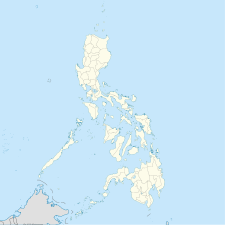
Iloilo, also called Iloilo Province, officially the Province of Iloilo, is a province in the Philippines located in the Western Visayas region. Its capital and largest city is Iloilo City, the regional center of Western Visayas and politically independent from the province. Iloilo occupies the southeast portion of the Visayan island of Panay and is bordered by the province of Antique to the west, Capiz to the north, the Jintotolo Channel to the northeast, the Guimaras Strait to the east, and the Iloilo Strait and Panay Gulf to the southwest.

Pototan, is a 1st class municipality in the province of Iloilo, Philippines. According to the 2020 census, it has a population of 78,298 people.

Roxas, officially the City of Roxas, is a 3rd class component city and capital of the province of Capiz, Philippines. According to the 2020 census, it has a population of 179,292 people, making it the most populous city in Capiz and also the second-most populous city in Western Visayas, after Iloilo City.

Iloilo City, officially the City of Iloilo, is a 1st class highly urbanized city in the Western Visayas region of the Philippines, located on the southeastern coast of the island of Panay. According to the 2020 census, Iloilo City has a population of 457,626 people, making it the most populous city in Western Visayas. For the metropolitan area, the total population is 1,007,945 people.

Central Philippine University is a private research university located in Jaro, Iloilo City, Philippines. Established in 1905 through the benevolent grant of the American industrialist and philanthropist John D. Rockefeller as the Jaro Industrial School and Bible School under the supervision of the American Baptist Foreign Mission Society, it is the first Baptist and second American and Protestant-founded university in the Philippines and in Asia.

West Visayas State University is a public normal research university located in La Paz, Iloilo City, Western Visayas region of the Philippines. It was established in 1924 as Iloilo Normal School under the tutelage of the Thomasites, but dates back its founding in 1902 as a part of Philippine normal school system with Iloilo National High School established by the American colonial government. It later became West Visayas State College in 1965 and acquired its university status becoming West Visayas State University in 1986.

Jaro is a district in Iloilo City, Philippines, located in Iloilo province, on Panay Island in the Western Visayas region. It is the largest district in terms of both geographical area and population, with 130,700 people according to the 2020 census. It is the seat of the Roman Catholic Archdiocese of Jaro, which encompasses the provinces of Iloilo, Guimaras, Antique, and Negros Occidental, as well as the center of the Candelaria devotion in the Philippines.

The PHINMA – University of Iloilo is a private, nonsectarian, coeducational institution in Iloilo City, Philippines. It was established in 1947 by the López family of Iloilo who founded the broadcasting giant ABS-CBN Corporation as Iloilo City Colleges. The university was later acquired by the business conglomerate group PHINMA Industries, and its current operations and management is controlled by the said company under its arm, PHINMA Education Network.

Philippine Women's University (PWU) is a coeducational tertiary education school which has its main campus in Manila, Philippines. An institution exclusive for girls from its inception until the 1970s, the PWU now admits both women and men as its students.

Vicente Sotto Memorial Medical Center (VSMMC) is a government-owned hospital in Cebu City, Philippines.

The Iloilo Mission Hospital, also known as CPU–Iloilo Mission Hospital, CPU–IMH, IMH, or Mission, is a private tertiary, academic, teaching hospital in Jaro, Iloilo City, Philippines, managed and operated as the university hospital of Central Philippine University. It was established in 1901 by American missionary doctor Joseph Andrew Hall as "the first Protestant and American-founded hospital in the Philippines".

The Central Philippine University College of Medicine, also referred to as CPU COM, CPU College of Medicine, CPU ColMed or CPU Medicine, is the medical school of Central Philippine University, a private university in Iloilo City, Philippines. Established in 2002 and opened in 2003 with its first dean, Dr. Glenn A. M. Catedral, it is one of the youngest colleges and academic units of the university.

Medical Colleges of Northern Philippines (MCNP) is a private, nonsectarian, tertiary-level, learning institution in Cagayan Valley, Philippines that offers courses for health professions. It was established in 1994 by Doctor Ronald P. Guzman, referred to as "Father Eagle" by the school's stakeholders.

The Federal State of the Visayas was a revolutionary state in the Philippine archipelago during the revolutionary period. It was a proposed administrative unit of a Philippines under a federal form of government.
The Mari-it Wildlife and Conservation Park is a protected area in Lambunao, Iloilo in the island of Panay in the Philippines. It is managed by the West Visayas State University–College of Agriculture and Forestry (WVSU-CAF). It was also the largest hornbill breeding facility in the world.
The Western Visayas Medical Center (WVMC) is a tertiary level government hospital in the Philippines with an authorized bed capacity of seven hundred (700). It is located along Q. Abeto Street, Mandurriao, Iloilo City, Iloilo.
The Western Visayas Sanitarium and General Hospital (WVSGH) is a government hospital in the Philippines. It is located in Barangay Inangayan and Barangay Bolong Oeste, Santa Barbara, Iloilo.
The Don Jose S. Monfort Medical Center (DJSMMC) is a government hospital in the Philippines It is located in Barotac Nuevo, Iloilo.

















